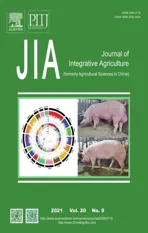Detection of arboviruses in Culicoides (Diptera:Ceratopogonidae)collected from animal farms in the border areas of Yunnan Province,China
2021-07-24DIDiLIChenxiLIZongjieWANGXinXIAQiqiMonaSHARMALIBeibeiLIUKeSHAODonghuaQIUYafengSoeSoeWAIYANGShibiaoWEIJianchaoMAZhiyong
DI Di,LI Chen-xi,LI Zong-jie,WANG Xin,XIA Qi-qi,Mona SHARMA,LI Bei-bei,LIU Ke,SHAO Dong-hua,QIU Ya-feng,Soe-Soe WAI,YANG Shi-biao,WEI Jian-chao,MA Zhi-yong
1 Shanghai Veterinary Research Institute,Chinese Academy of Agricultural Sciences,Shanghai 200241,P.R.China
2 Yunnan Tropical and Subtropical Animal Virus Diseases Laboratory,Yunnan Animal Science and Veterinary Institute,Kunming 650224,P.R.China
3 Department of Veterinary Public Health,University of Veterinary Science,Yezin 15013,Myanmar
Abstract Biting midges of the genus Culicoides (order Diptera,family Ceratopogonidae) are potential biological vectors for the transmission of certain arboviruses among humans,livestock,and wild animals.This study collected a total of 405 Culicoides individuals from seven animal farms located in five counties in the border areas of Yunnan Province,China,and examined the Culicoides species composition and the major arboviruses carried by the Culicoides species.The collected Culicoides were classified into seven species with variable abundances: Culicoides arakawae (5.43%,22/405),Culicoides homotomus(1.23%,5/405),Culicoides obsoletus (19.75%,80/405),Culicoides orientalis (17.28%,70/405),Culicoides oxystoma(29.38%,119/405),Culicoides peregrinus (5.68%,23/405),and Culicoides nipponensis (21.23%,86/405).Among the seven species,C.oxystoma and C.nipponensis were distributed in all the five counties with abundances of 13.33–44.87% and 10.00–46.83%,respectively,suggesting that these were the dominant species of Culicoides widespread on animal farms in the border areas.PCR was used to detect major arboviruses in the collected Culicoides specimens,including bluetongue virus (BTV),Japanese encephalitis virus,Dengue virus,Zika virus,African swine fever virus,and African horse sickness virus.Among the tested viruses,only BTV serotype 1 was tested positive in C.oxystoma specimens collected from a buffalo farm.Culicoides oxystoma was the dominant species on animal farms in the sampled areas,but it has not previously been documented as positive for BTV in China.The current results thus suggest that C.oxystoma could be an important vector for BTV transmission in these border areas,which,however,needs to be confirmed by further comprehensive experiments.Overall,the present study provides the first profile of Culicoides species on animal farms in the China,Vietnam,and Myanmar border areas,establishes the prevalence of arboviruses carried by these Culicoides species,and suggests the vector potential of C.oxystoma species for the transmission of BTV.
Keywords:biting midge,Culicoides,bluetongue virus,arbovirus,arthropod vector
1.Introduction
Arboviruses comprise the largest biological group of vertebrate viruses.They are transmitted by arthropod vectors and pose serious threats to human and animal health (Younget al.2018).Nearly 500 arboviruses are known,some of which cause diseases in endothermic vertebrates (Hubaleket al.2014).The main arthropod vectors responsible for the biological transmission of arboviruses include mosquitoes,sandflies,midges,and ticks(Conwayet al.2014),which carry arboviruses from viremic to susceptible hosts during blood-sucking.
Although mosquitoes are considered as the major arthropod vectors of arboviruses,other blood-feeding arthropods such as biting midges can also transmit certain arboviruses.Biting midges of the genusCulicoides(order Diptera,familyCeratopogonidae) are mainly known as vectors of bluetongue virus (BTV) and Schmallenberg virus(Reynoldset al.2017).FemaleCulicoidesfeed on blood for egg development and therefore have significant potential for transmitting arboviruses among humans,livestock,and wild animals (Hubaleket al.2014).Over 50 arboviruses have been isolated fromCulicoidesspecies to date,suggesting a role in the transmission of veterinary (Wagneret al.2008)and human diseases (Spinelliet al.2013).
Yunnan is a frontier province in southwestern China adjacent to Myanmar,Laos,and Vietnam.Ecologically,Yunnan has tropical and south subtropical climates and provides shelter for numerous arthropod vectors and their hosts,and it is thus conducive to the maintenance and transmission of existing arboviruses,as well as the emergence of new arboviruses.Several arboviruses,including BTV,Japanese encephalitis virus (JEV),Dengue virus (DENV),Getah virus,Banna virus,and Kadipiro virus,are prevalent in Yunnan,among which Banna virus was initially isolated from a human patient with encephalitis in Yunnan in 1987 (Sunet al.2009).
There are approximately 1 368 species ofCulicoidesworldwide,of which 347 are found in China and at least 39 species have been reported to occur in Yunnan (Borkent and Wirth 1997).Several arboviruses,such as BTV and Tibet orbivirus (Wanget al.2017),have been isolated fromCulicoidescollected in Yunnan,suggesting the potential impact ofCulicoideson public health and animal husbandry in the area.Furthermore,cross-border trade is booming in the border areas of Yunnan,providing convenient conditions for cross-border transmission of arboviruses and their arthropod vectors such asCulicoides.Therefore,information onCulicoidesspecies and the arboviruses carried by these vector species in the border areas of Yunnan is essential in assessing the risk of transboundary arboviral diseases.This study collected and analyzed theCulicoidesspecimens from animal farms located in the border areas of Yunnan and the major arboviruses carried by the specimens.
2.Materials and methods
2.1.Sample collection
Culicoidesspecimens were collected from seven animal farms located in Tengchong (TC),Longchuan (LC),Ruili (RL),Mangshi (MS),and Hekou (HK) counties in Yunnan close to the border during 18–23 June 2018 (Fig.1;Table 1) using black UV-light traps (Photocatalytic Technology Mosquito Catcher Device,Electrical Technology Co.,Ltd.,Guangdong,China).The aperture of the net pocket was reduced to capture smaller insects.Five traps were set for each farm,including three placed in different barns and two under the eaves outside.All traps were suspended 2 m above the ground and operated for one night from 6:00 p.m to 6:00 a.m next morning (Liuet al.2018).The collectedCulicoidesspecimens were stored in 95% ethanol for further use.
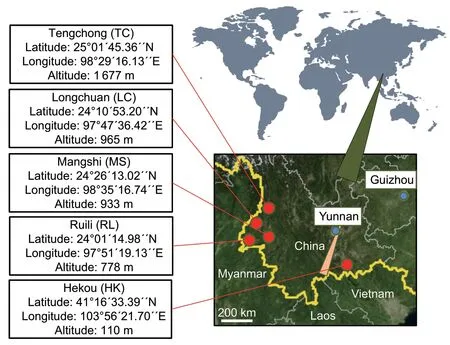
Fig.1 Locations of Culicoides sampling sites in the border areas of Yunnan Province,China.
Two hundred blood samples were randomly collected from four cattle farms located in TC,LC,RL,and MS counties in Yunnan in June 2018 (detailed distribution of samples in each site is shown in Appendix A).The sera were separated by centrifugation at 3 000 r min–1for 5 min,and stored at–20°C until use.All sera were assayed for BTV-specific antibodies using Bluetongue Competition Ab Test Kit (IDEXX Montpellier SAS,Montpellier,France)according to the manufacturer’s instructions.
2.2.ldentification of Culicoides species
EachCulicoidesindividual collected was examined on microscope slides under a microscope to determine the species and gender based on the gender morphology and the wing spot patterns as described previously by Liuet al.(2018).Abdomens were left for subsequent molecular identification,and heads and thoraxes were used for subsequent arbovirus detection.
After the morphological identification,the abdomen of eachCulicoidesindividual was dissected for molecular identification to confirm the morphology analysis results by DNA barcoding using the cytochrome oxidase subunit I(COI) gene from the mitochondrial genome (Liuet al.2018).Total DNA was extracted from the abdomen of eachCulicoidesindividual using a HiPure Insect DNA Kit(Magen,Guangdong,China) and was used as a template for PCR amplification of COI gene.PCR was performed using Premix Taq Version 2.0 plus dye (TaKaRa,Liaoning,China) with a universal primer pair (Appendix B).The PCR conditions were as follows:initial denaturation at 94°C for 5 min,35 cycles at 94°C for 30 s,58°C for 30 s,72°C for 45 s,and a final extension at 72°C for 10 min.The amplified COI genes were sequenced and subsequently blasted against the reference COI genes deposited in the GenBank database for molecular identification.
2.3.Detection of arboviruses by PCR
FemaleCulicoideswhich feed on blood (Melloret al.2000)have significant potential for transmitting arboviruses among hosts (Hubaleket al.2014).FemaleCulicoideswere thus chosen for the detection of arboviruses by PCR.Primers and probes used for the detection of BTV,JEV,DENV,African swine fever virus (ASFV),African horse sickness virus (AHSV),and Zika virus (ZIKV) were designed based on previous studies (Appendix B).After molecular identification,heads and thoraxes of all female individuals from same species identified on each animal farm were dissected and pooled together with a pool size of 10 individuals or less depending on the number of collected specimens.The pooled heads and thoraxes were ground with phosphate-buffered saline using a disposable grinding rod and centrifuged to remove debris.The resulting supernatants were subjected to viral DNA/RNA extraction using a TIANamp Virus DNA/RNA Kit (Tiangen,Beijing,China).The extracted RNA was reverse transcribed into a complementary DNA using a PrimeScript™RT Reagent Kit with gDNA Eraser (Perfect Real-Time)(TaKaRa).PCR detection of arboviruses was carried out using Premix Taq Version 2.0 plus dye (TaKaRa).PCRpositive samples were further confirmed by DNA sequencing.The resulting sequences of viral genes were aligned against the reference strains deposited in the GenBank database.
2.4.Phylogenetic analysis
The sequences of COI genes and viral genes amplified by PCR were subjected to phylogenetic analysis.A genetic-distance matrix was calculated using a Kimura twoparameter model with MEGA 6.0 Software.A molecularsystem tree was constructed by the neighbor-joining method,and the confidence values of each node in the system tree were tested by bootstrapping 1 000 times.
3.Results
3.1.Overview of collected Culicoides species
The locations of theCulicoidessampling points are shown in Fig.1.A total of 405Culicoidesindividuals were collected from five counties,with the highest number (130) in TC and the lowest number (56) in LC (Table 1).EachCulicoidesindividual was identified morphologically and subsequently subjected to molecular identification by DNA barcoding with COI genes.The morphological identification was combined with the molecular identification for the determination ofCulicoidesspecies.This was because some species,such asC.obsoletusandCulicoides scoticus,were difficult to be distinguished morphologically,and required the molecular identification to confirm the primary morphological identification (Augotet al.2010).Based on the results obtained from the morphological and molecular identifications,the collectedCulicoidesspecimens were classified into seven species:C.arakawae,C.homotomus,C.obsoletus,C.orientalis,C.oxystoma(Appendix C),C.peregrinus,andC.nipponensis(Table 1).Phylogenetic analysis of theCulicoidesspecies identified in this study is shown in Fig.2 and the sequences of COI genes of the identified species are listed in Appendix D.Culicoides oxystomawas the most abundant species accounting for 29.38% (119/405),followed byC.nipponensis,(21.23%,86/405),C.obsoletus(19.75%,80/405),C.orientalis(17.28%,70/405),C.peregrinus(5.68%,23/405),C.arakawae(5.43%,22/405),andC.homotomus(1.23%,5/405).
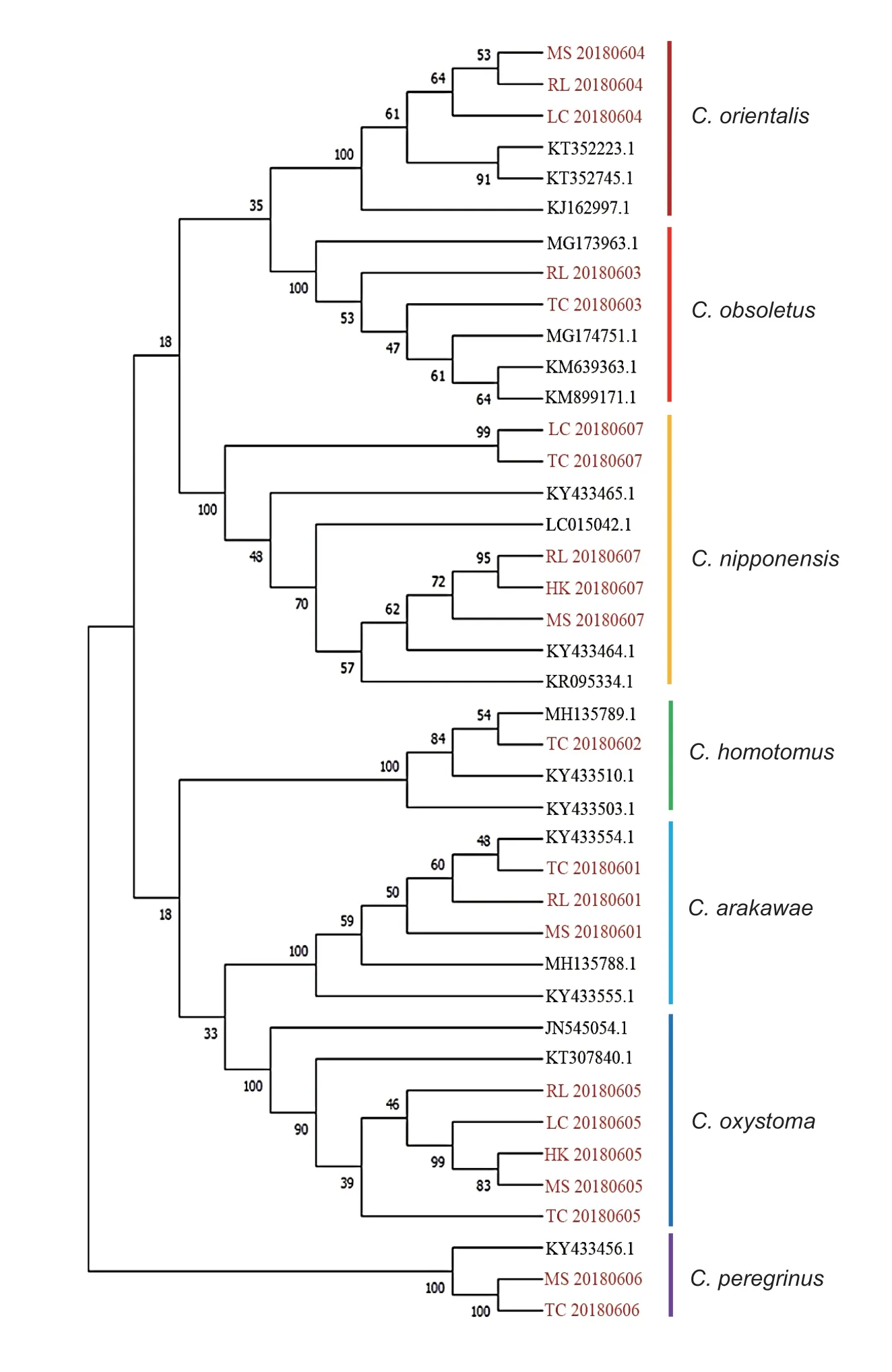
Fig.2 Phylogenetic analysis of cytochrome oxidase subunit I (COI) genes of the identified Culicoides species.The species identified in this study are highlighted with red color.Each COI sequence of Culicoides species retrieved from GenBank database is represented by its GenBank accession number.

32.10 13.83 20.00 19.26 14.81 Total Percentage (%)130 56 81 78 60 405 13(♂2,♀11)8 (♂2,♀6)18(♂4,♀14)14(♂8,♀6)0 (♂0,♀0)16(♂2,♀14)17(♂4,♀13)86 21.23 C. peregrinus C.nipponensis 0 (♂0,♀0)0 (♂0,♀0)0 (♂0,♀0)0 (♂0,♀0)0 (♂0,♀0)6 (♂4,♀2)23 5.68 C. oxystoma 43(♂15,♀28) 17 (♂10,♀7)0 (♂0,♀0)15(♂0,♀15)0 (♂0,♀0)18(♂13,♀5)35(♂10,♀25)8 (♂1,♀7)119 29.38 C. orientalis 0 (♂0,♀0)0 (♂0,♀0)35(♂10,♀25)0 (♂0,♀0)0 (♂0,♀0)15(♂2,♀13)70 17.28 Table 1Collection andidentificationof Culicoides speciesin Yunnan Province of China C. obsoletus 32(♂11,♀21) 20 (♂15,♀5)9 (♂5,♀4)6 (♂2,♀4)0 (♂0,♀0)6 (♂0,♀6)27(♂14,♀13)0 (♂0,♀0)80 19.75 C. homotomus 5 (♂0,♀5)0 (♂0,♀0)0 (♂0,♀0)0 (♂0,♀0)0 (♂0,♀0)0 (♂0,♀0)0 (♂0,♀0)5 1.23 C. arakawae 0 (♂0,♀0)0 (♂0,♀0)0 (♂0,♀0)0 (♂0,♀0)8 (♂2,♀6)0 (♂0,♀0)14(♂8,♀6)22 5.43 Animal Buffalo Swine Buffalo Buffalo Swine Swine Cattle Farm BFL YEY MX NDJ YPY MYJ GY County Tengchong (TC)Longchuan (LC)Ruili (RL)Hekou (HK)Mangshi (MS)Total Percentage(%)
3.2.Different compositions and abundances of Culicoides species among the five counties
The species compositions and abundances ofCulicoidesspecies differed among the five counties (Fig.3;Table 1).Culicoides oxystomaandC.nipponensiswere distributed in all the five counties with abundances of 13.33–44.87 and 10.00–46.83%,respectively,whileC.homotomuswas only identified in TC,with an abundance of 3.85% (Fig.3;Appendix E).Culicoides oxystomaandC.nipponensiswere thus the most widespread species.Culicoides oxystomawas the dominant species in TC and HK,with abundances of 33.08 and 44.87%,respectively,whileC.nipponensiswas the major species in LC and MS,with abundances of 46.43 and 28.33%,respectively.Culicoides orientaliswas the dominant species in RL,with an abundance of 43.21% (Fig.3;Appendix E).TC contained six out of the sevenCulicoidesspecies identified,showing the richestCulicoidesspecies composition,whereas LC and HK harbored only three species each (Fig.3).The species distributions also differed among the animal farms.Culicoides oxystomaandC.nipponensiswere present in all types of farms,including buffalo,cattle,and swine farms,whileC.orientaliswas absent from swine farms (Table 1).Overall,these data indicated that theCulicoidesspecies compositions differed among the five counties on the Yunnan border,withC.oxystomaandC.nipponensisbeing the dominant and most widespread species.
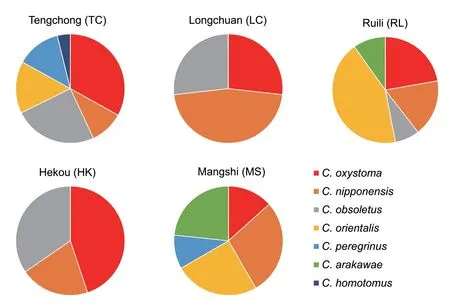
Fig.3 Composition and diversity of Culicoides species in each county in Yunnan Province,China.
3.3.BTV serotype 1 (BTV-1) was tested positive in C.oxystoma specimens
Culicoidesact as biological vectors for the transmission of BTV.A total of 13 serotypes of BTV have been reported in Yunnan,of which serotypes 1,2,3,4,12,15,and 16 are currently prevalent (Zhanget al.2004;Hubaleket al.2014).Therefore,this study investigated the presence of these serotypes of BTV in the collectedCulicoidesspecimens by PCR with primers specific to VP2 gene.To this end,heads and thoraxex of all female individuals from same species identified on each animal farm were pooled together with a pool size of 10 individuals or less,which generated a total of 38 specimenpools consisting of two ofC.arakawae,one ofC.homotomus,eight ofC.obsoletus,six ofC.orientalis,ten ofC.oxystoma,one ofC.peregrinus,and ten ofC.nipponensisspecimen pools for PCR detection of BTVs (Appendix A).Among the 38Culicoidesspecimen pools,a pool ofC.oxystomaspecimens (10 individuals)collected from a buffalo farm in TC County was tested positive for BTV-1,and other pools were negative for all BTV serotypes tested.The VP2 gene of BTV-1 (named as TC201807) detected in the pool ofC.oxystomaspecimens was sequenced (Appendix D) and compared with the reference BTV serotype strains deposited in GenBank by BLAST analysis.The identities of amino acid and nucleotide sequences of VP2 between TC201807 and the reference BTV-1 strains were 98.37–99.56 and 94.07–97.44%,respectively (Table 2).Phylogenetic analysis indicated that the BTV-1 (TC201807) detected in the C.oxystoma specimens was most closely matched with BTV-1 strain Y863 isolated from sheep during a severe outbreak in Yunnan in 1979 (Fig.4).
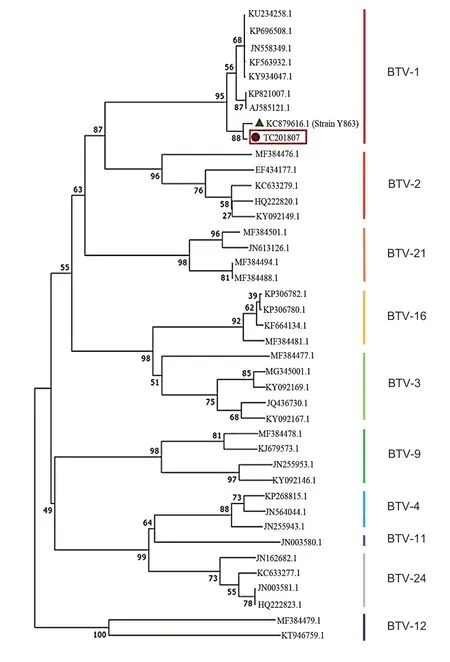
Fig.4 Phylogenetic analysis of VP2 genes of BTV (bluetongue virus) serotypes present in Yunnan Red box indicates the BTV-1 TC201807 detected in Culicoides oxystoma specimens in this study.Each BTV strain is represented by its GenBank accession number.

Table 2 Sequence identities of VP2 between TC201807 and other of BTV serotype 1 strains
Two hundred sera samples were randomly collected from the four cattle farms located in TC,LC,RL,and MS,among which 82 sera (41.0%) were seropositive for BTV-specific antibodies based on the results of a commercial,BTV groupspecific antibody detection kit (Appendix A),which is similar to previous reports (Kirklandet al.2002).
3.4.Other major arboviruses were not detected in Culicoides specimens
Their blood-sucking habit means thatCulicoidesspecies might be involved in the biological or mechanical transmission of certain arboviruses.This study therefore investigated the presence of several arboviruses in the 38Culicoidesspecimen pools (Appendix A),including JEV and DENV(endemic in Yunnan) (Guoet al.2015),ZIKV (absent in Yunnan but present in neighboring Guizhou Province) (Fuet al.2017),ASFV (responsible for current outbreak of African swine fever in China),and AHSV (present in Africa,Europe,and the Middle East) (Poweret al.2014;Carpenteret al.2017).JEV,DENV and ZIKV belonging toFlavivirusgenus withFlaviviridaefamily are mainly transmitted by several species of mosquitoes (Tunoet al.2017).ASFV,the only member ofAsfarviridaefamily,is transmittedviacontact among infected animals,intake of infected material,and/or soft ticks ofOrnithodorosgenus (Kleiboekeret al.1999).AHSV is a member ofOrbivirusgenus withinReoviridaefamily and is principally transmitted byCulicoidesbiting midges (Carpenteret al.2017).PCR showed that all theCulicoidesspecimens were negative for all these arboviruses,suggesting the absence of these arboviruses inCulicoidesat the sampled locations.
4.Discussion
Livestock,including cattle and pigs,have recently been traded from Vietnam and Myanmar into Chinaviathe border areas in Yunnan.The main animal husbandry in these areas involves small-scale family farms,some of which are close to residential areas.Poor sanitary conditions and abundant hosts provide excellent breeding grounds for arthropods and arboviruses,posing potentially severe impacts on the local animal husbandry industry and public health.In addition,these areas have long been affected by BTV (Duanet al.2019a,b),which is mainly transmitted byCulicoidesspecies such asCulicoides actoni.This study therefore surveyed the species compositions and abundances ofCulicoidescollected from seven animal farms located in five counties in the border areas of Yunnan,and investigated the presence of BTV and other major arboviruses in the collectedCulicoidesspecimens.
A total of 405Culicoidesindividuals collected in this study were classified into seven species (C.arakawae,C.homotomus,C.obsoletus,C.orientalis,C.oxystoma,C.peregrinus,andC.nipponensis),all of which have been documented previously in Yunnan and its neighboring regions (Liuet al.2018).The most abundant species wasC.oxystomaaccounting for 29.38%,followed byC.nipponensis(21.23%),C.obsoletus(19.75%),C.orientalis(17.28%),C.peregrinus(5.68%),C.arakawae(5.43%),andC.homotomus(1.23%).To the best of our knowledge,this provides the first profile ofCulicoidesspecies on animal farms in the border areas of China,Vietnam,and Myanmar.
The number (405) ofCulicoidesspecimens collected in this study was relatively small.Similar data have been reported in previous studies (Duanet al.2019a,b),in which 108 and 107Culicoidesindividuals were collected in Xiaozhongdian and Nixi,respectively,in Yunnan.The collection sites may influence the number ofCulicoidesindividuals collected.For example,591Culicoidesindividuals were collected in Jianjiang.In addition,it was raining on the night of collection in this study,which might influence the collection number.
Culicoides oxystomaandC.nipponensiswere distributed in all the five counties with abundances of 29.38 and 21.23%,respectively,suggesting that thesespecies represented the dominant and most widespread ones on animal farms in the border areas of Yunnan.These results were different from a previous survey carried out in Shangri-La of Yunnan,in whichC.tainanus,C.nielamensisandC.obsoletusdominantly comprise 98% of all specimens collected (Duanet al.2019a,b).The altitude of collection sites in Shangri-La is 1 800–3 300 m that is higher than that (110–1 677 m) in this study.The different composition ofCulicoidesspecies might be attributable to the difference in the ecological environment of collection sites (Duanet al.2019a,b).In addition,data of this study were compared with a survey performed in the neighboring Jiangxi Province (Liuet al.2018).The dominantCulicoidesspecies differed between these surveys,with the most abundant species in Jiangxi beingC.arakawae(61.89%),followed byC.oxystoma(13.77%) (Liuet al.2018).This apparent difference in dominant species could be attributable to the different habitats sampled,withC.oxystomausually being captured in residential areas,hospitals,and pig and cattle habitats,whileC.arakawaebeing the predominant species on chicken farms,vegetable plots,and peasant household habitats (Liuet al.2018).
Culicoides oxystomais distributed worldwide and is considered to be involved in the transmission of several arboviruses such as BTV,AHSV,and Akabane hemorrhagic disease virus in some countries (Kurogiet al.1987;Yanaseet al.2005;Dadawalaet al.2012;Fallet al.2015).This study detected BTV-1 inC.oxystomaspecimens collected from a buffalo farm in the TC County,further reinforcing the significance ofC.oxystomain the transmission of BTV.Culicoides nipponensishas previously been identified in China (Liuet al.2018),Japan (Yanaseet al.2013),and Korea (Yanget al.2018).The role ofC.nipponensisin the transmission of arboviruses is largely unknown,but it has been considered to be involved in the transmission of bovine ephemeral fever virus (Jaekuet al.2013).As the dominantCulicoidesspecies in the border areas of Yunnan,the vector potentials ofC.oxystomaandC.nipponensisfor the transmission of arboviruses should be further investigated and routinely monitored to assess the risk of arboviral diseases (Cohnstaedtet al.2012).
BTV is the prototype of the genusOrbivirus,familyReoviridae,and is responsible for causing bluetongue,which is an arthropod-borne disease of domestic and wild ruminants.To date,27 serotypes of BTV have been documented worldwide (Belbiset al.2017) including Yunnan,the main prevalent region of BTV in China (Belbiset al.2017).BTV is mainly transmitted by several different species ofCulicoides,depending on theCulicoidesspecies present in the region (De Liberatoet al.2005;van der Sluijset al.2016).BTV is thought to be transmitted byC.actoni,Culicoides inicola,Culicoides macalatus,andCulicoides morientaliin Yunnan,whileC.oxystomahas not been reported to harbor BTV in this province.However,the current study detected BTV-1 in head and thorax tissues fromC.oxystomaspecimens,suggesting the successful dissemination of BTV inC.oxystomaand thus the potential involvement ofC.oxystomain the transmission of BTV in the border region of Yunnan.Buffalo on the farm where the BTV-positiveCulicoidesspecimens were collected were clinically healthy,and no bluetongue infection was noticed.The BTV-1 detected inC.oxystomawas thus likely derived from viremic buffalo with subclinical BTV infection (Purseet al.2005).Consistent with this study,C.oxystomawas considered to transmit BTV in the Middle East (Wirth and Dyce 1985).However,further comprehensive experiments are needed to determine ifC.oxystomaplays an essential role in the transmission of BTV in Yunnan.In addition,this study could not definitely exclude the involvement of the other six identifiedCulicoidesspecies in the transmission of BTV,even though BTV was not detected in the current specimens of these species.
In addition to BTV,Culicoidesspecies might be also involved in the biological or mechanical transmission of other arboviruses because of their blood-sucking habit.This study therefore investigated the presence of several arboviruses in the collectedCulicoidesspecimens.However,it found no evidence of JEV,DENV,ZIKV,ASFV,or AHSV in the collectedCulicoidesspecimens.China is free of AHSV,but JEV is endemic in Yunnan (Liuet al.2013) and has previously been isolated fromCulicoides.The absence of JEV in the currentCulicoidesspecimens,which were collected in the prevalent season for JEV,suggested that the detectedCulicoidesspecies might play little or no role in the transmission of JEV in the sampled area.Indeed,mosquitoes other thanCulicoidesspecies have been shown to be the principal vector in the transmission of JEV (Wanget al.2007).DENV is endemic in Yunnan (Guoet al.2015),while ZIKV is absent from Yunnan but has been isolated from mosquitoes in neighboring Guizhou Province (Fuet al.2017).The negative results for DENV and ZIKV in theCulicoidesspecimens in the present study suggested thatCulicoidesspecies were probably not involved in the transmission of these viruses,which are mainly transmitted by mosquitoes (Fuet al.2017).China,including Yunnan,is currently experiencing an outbreak of African swine fever caused by ASFV.ASFV is mainly transmitted by soft ticks of the genusOrnithodorosin a sylvatic cycle (Galindo and Alonso 2017),but has also been reported to be transmitted mechanically into swine farms by stable flies (Stomoxys calcitrans) under experimental conditions (Forthet al.2018).A possible involvement ofCulicoidesin the mechanical transmission of ASFV should therefore not be neglected,especially during an outbreak of ASFV,despite the negative results for ASFV in theCulicoidessamples collected from swine farms in this study.
The border areas sampled in the present study have a criss-crossing tropical/subtropical climate with complex topography and large altitude differences.The annual average temperature is >15°C and the relative humidity is >70%,making suitable year-round conditions for bloodsucking insects includingCulicoides(Blandaet al.2018).Culicoidescan spread across borders by various means,including animals,air currents,and in wine and transport vehicles.BTV was reportedly introduced into British Columbia in 1987 and 1988,probably by wind-borne infectedCulicoides.BTV,JEV,and DENV are endemic in the border areas in Yunnan (Forthet al.2018),and crossborder transmission of these arboviruses byCulicoidesspecies is difficult to prevent because they spread quickly and cannot be observed easily.It is therefore necessary to carry out routine surveillance ofCulicoidesspecies and the arboviruses carried by them to control transboundary movement of arboviral diseases.
5.Conclusion
A total of 405Culicoidesindividuals were collected from seven animal farms located in five counties in the border areas of Yunnan Province.The collected individuals were classified into seven species with variable abundance:C.arakawae,C.homotomus,C.obsoletus,C.orientalis,C.oxystoma,C.peregrinus,andC.nipponensis,of whichC.oxystomaandC.nipponensiswere distributed in all the five counties with high abundances,representing the dominant and most widespread species in the areas.JEV,DENV,ZIKV,ASFV,and AHSV were undetected in 38Culicoidespools,but BTV-1 (1/38 pools) was detected inC.oxystomaspecimens collected from a buffalo farm in TC County.The dominance ofC.oxystomathus suggests that it might be an important vector for BTV transmission in the border area,which,however,needs to be confirmed by further comprehensive experiments.Overall,this study provides the first profile ofCulicoidesspecies present on animal farms in the border areas of China,Vietnam,and Myanmar,establishes the prevalence of arboviruses carried by theseCulicoidesspecies,and suggests the vector potential ofC.oxystomaspecies for the transmission of BTV.
Acknowledgements
This work was supported by the National Key Research and Development Program of China (2017YFD0501805),the Natural Science Foundation of Shanghai,China(19ZR1469000),the Shanghai Science and Technology Development Funds (17391901600),and the Project of International Science and Technology Cooperation,China(2014DFE30140).
Declaration of competing interest
The authors declare that they have no conflict of interest.
Ethical approval
All applicable internaltional,national and institutional guidelines for the care and use of animals were followed.
Appendicesassociated with this paper are available on http://www.ChinaAgriSci.com/V2/En/appendix.htm
杂志排行
Journal of Integrative Agriculture的其它文章
- Molecular characteristics and structure–activity relationships of food-derived bioactive peptides
- lntegrating the physical and genetic map of bread wheat facilitates the detection of chromosomal rearrangements
- Physiological response of flag leaf and yield formation of winter wheat under different spring restrictive irrigation regimes in the Haihe Plain,China
- Variation of carbon partitioning in newly expanded maize leaves and plant adaptive growth under extended darkness
- Effects of plant density and mepiquat chloride application on cotton boll setting in wheat–cotton double cropping system
- Interactive effect of shade and PEG-induced osmotic stress on physiological responses of soybean seedlings
